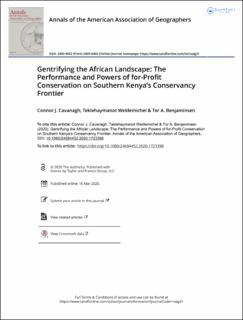| dc.contributor.author | Cavanagh, Connor Joseph | |
| dc.contributor.author | Weldemichel, Teklehaymanot | |
| dc.contributor.author | Benjaminsen, Tor A | |
| dc.date.accessioned | 2020-03-25T13:44:10Z | |
| dc.date.available | 2020-03-25T13:44:10Z | |
| dc.date.created | 2020-03-17T20:04:33Z | |
| dc.date.issued | 2020 | |
| dc.identifier.citation | Annals of the American Association of Geographers. 2020, 1-19. | en_US |
| dc.identifier.issn | 2469-4452 | |
| dc.identifier.uri | https://hdl.handle.net/11250/2648623 | |
| dc.description.abstract | Across eastern and southern Africa, conservation landscapes increasingly extend far beyond the boundaries of government-owned protected areas. Several countries have now granted full legal recognition to various types of private or otherwise nonstate conservation arrangements, thereby often seeking to create novel opportunities for ostensibly “green” capital investments in various for-profit conservation enterprises. Following the adoption of the 2013 Wildlife Conservation and Management Act in Kenya, for instance, nonstate conservancies now encompass 6.36 million hectares—or 11 percent of the country’s land area—with at least a further 3 million hectares proposed or in the process of territorialization. Examining the consequences of this precipitous rise of conservancies in southern Kenya’s Maasai Mara region, we suggest that—in addition to significant potential for considerable profit margins to be realized by individual firms—these investments retain a number of other unique powers or capacities to transform prevailing varieties of environmental governance. In this case, these capacities manifest in two interrelated forms: first, in the dissemination of environmental crisis narratives that stigmatize pastoralist communities and thus drive down land rents or values and, second, in the recapitalization of conservation territories and the reconfiguration of prevailing land uses in ways that enable novel forms of rural gentrification via the capture of heightened or differential ground rents. | en_US |
| dc.language.iso | eng | en_US |
| dc.publisher | Taylor & Francis | en_US |
| dc.rights | Attribution-NonCommercial-NoDerivatives 4.0 Internasjonal | * |
| dc.rights.uri | http://creativecommons.org/licenses/by-nc-nd/4.0/deed.no | * |
| dc.title | Gentrifying the African Landscape: The Performance and Powers of for-Profit Conservation on Southern Kenya’s Conservancy Frontier | en_US |
| dc.type | Peer reviewed | en_US |
| dc.type | Journal article | en_US |
| dc.description.version | publishedVersion | en_US |
| dc.source.pagenumber | 1-19 | en_US |
| dc.source.journal | Annals of the American Association of Geographers | en_US |
| dc.identifier.doi | https://doi.org/10.1080/24694452.2020.1723398 | |
| dc.identifier.cristin | 1802136 | |
| dc.description.localcode | ß2020 The Author(s). Published with license by Taylor and Francis Group, LLC.This is an Open Access article distributed under the terms of the Creative Commons Attribution-NonCommercial-NoDerivatives License (http://creativecommons.org/licenses/by-nc-nd/4.0/), which permits non-commercial re-use, distribution, and reproduction in any medium, provided the original work is properly cited, and is not altered,transformed, or built upon in any wa | en_US |
| cristin.unitcode | 194,67,10,0 | |
| cristin.unitname | Institutt for geografi | |
| cristin.ispublished | true | |
| cristin.fulltext | original | |
| cristin.qualitycode | 1 | |

